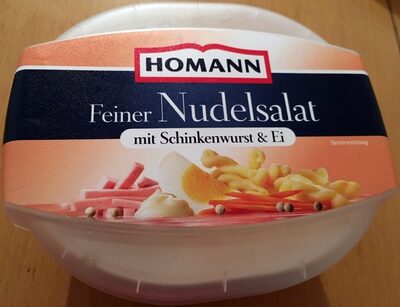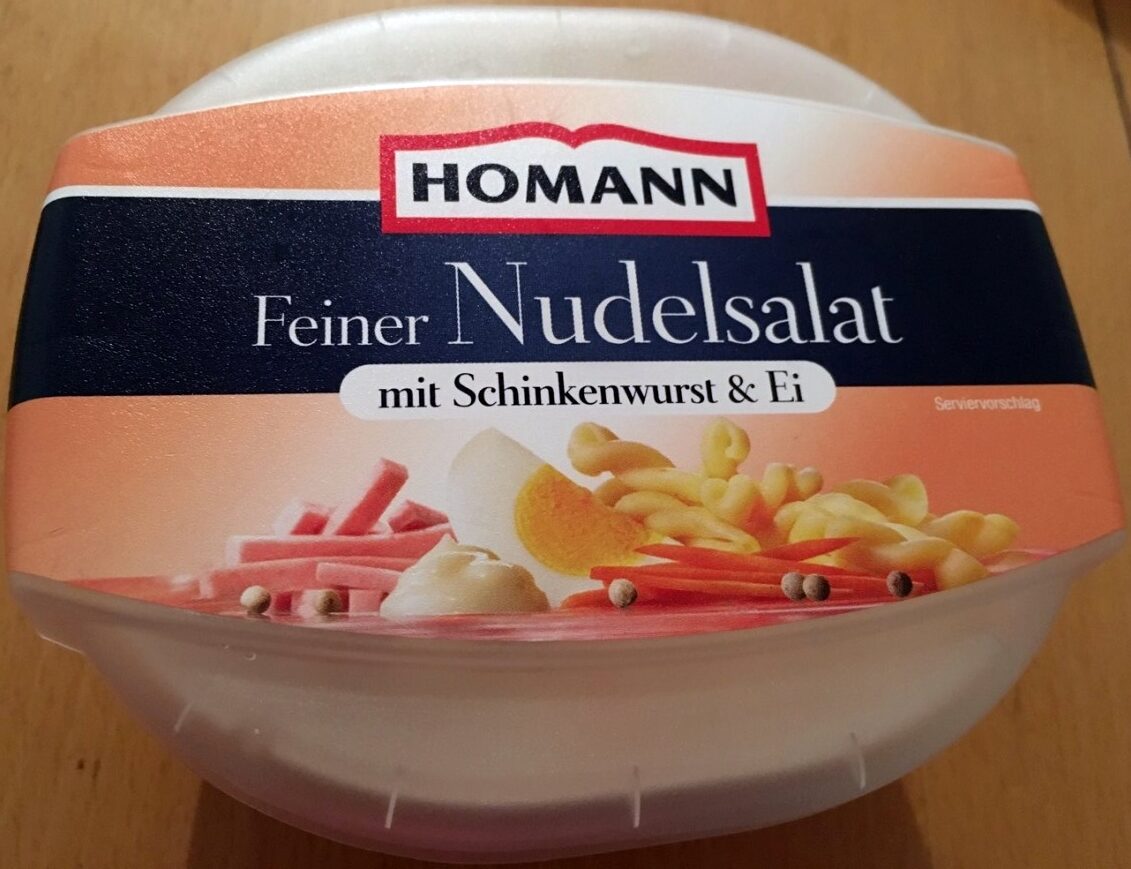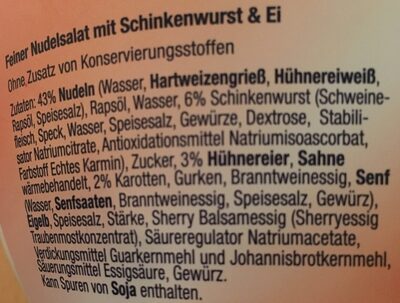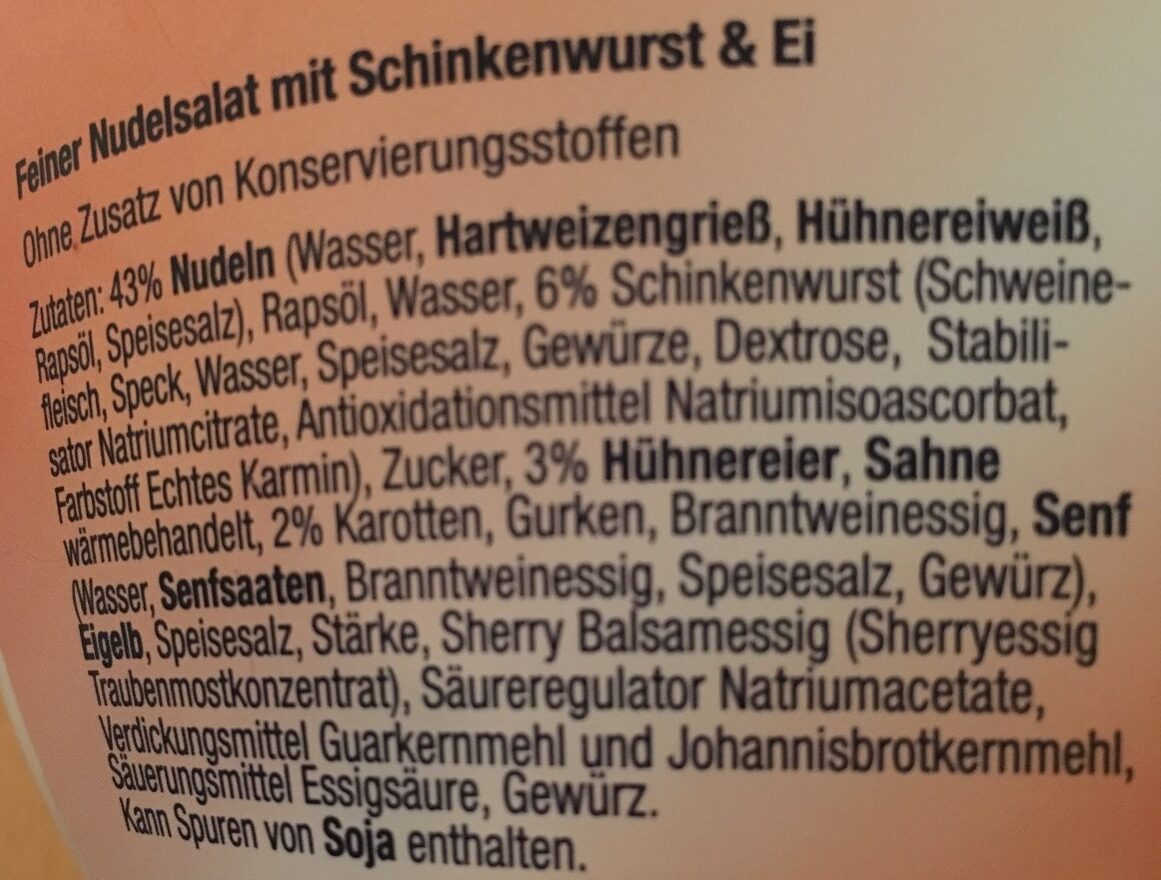Help us make food transparency the norm!
As a non-profit organization, we depend on your donations to continue informing consumers around the world about what they eat.
The food revolution starts with you!
Feiner Nudelsalat mit Schinkenwurst & Ei - Homann
Feiner Nudelsalat mit Schinkenwurst & Ei - Homann
This product page is not complete. You can help to complete it by editing it and adding more data from the photos we have, or by taking more photos using the app for Android or iPhone/iPad. Thank you!
×
Barcode: 4030800120543 (EAN / EAN-13)
Packaging: Plastic
Brands: Homann
Categories: Meals, Pasta dishes, Prepared salads, Pasta salads, Salads
Stores: Rewe
Countries where sold: France, Germany, Switzerland
Matching with your preferences
Health
Ingredients
-
46 ingredients
: 43% Nudeln (Wasser, Hartweizengrieß, Hühnereiweiß, Rapsöl, Speisesalz), Rapsöl, Wasser, 6% Schinkenwurst (Schweinefleisch, Speck, Wasser, Speisesalz, Gewürze, Dextrose, Stabilisator Natriumcitrate, Antioxidationsmittel Natriumisoascorbat, Farbstoff Echtes Karmin), Zucker, 3% Hühnereier, Sahne wärmebehandelt, 2% Karotten, Gurken, Branntweinessig, Senf, Wasser, Senfsaaten, Branntweinessig, Speisesalz, Gewürz), Eigelb, Speisesalz, Stärke, Sherry Balsamessig (Sherryessig Traubenmostkonzentrat), Säureregulator Natriumacetate, Verdickungsmittel Guarkernmehl und Johannisbrotkernmehl, Säuerungsmittel Essigsäure, Gewürz.Allergens: Eggs, Gluten, MustardTraces: Soybeans
Food processing
-
Ultra processed foods
Elements that indicate the product is in the 4 - Ultra processed food and drink products group:
- Additive: E120 - Cochineal
- Ingredient: Colour
- Ingredient: Dextrose
- Ingredient: Glucose
- Ingredient: Thickener
Food products are classified into 4 groups according to their degree of processing:
- Unprocessed or minimally processed foods
- Processed culinary ingredients
- Processed foods
- Ultra processed foods
The determination of the group is based on the category of the product and on the ingredients it contains.
Additives
-
E120 - Cochineal
Carminic acid: Carminic acid -C22H20O13- is a red glucosidal hydroxyanthrapurin that occurs naturally in some scale insects, such as the cochineal, Armenian cochineal, and Polish cochineal. The insects produce the acid as a deterrent to predators. An aluminum salt of carminic acid is the coloring agent in carmine. Synonyms are C.I. 75470 and C.I. Natural Red 4. The chemical structure of carminic acid consists of a core anthraquinone structure linked to a glucose sugar unit. Carminic acid was first synthesized in the laboratory by organic chemists in 1991.Source: Wikipedia
-
E260 - Acetic acid
Acetic acid: Acetic acid , systematically named ethanoic acid , is a colorless liquid organic compound with the chemical formula CH3COOH -also written as CH3CO2H or C2H4O2-. When undiluted, it is sometimes called glacial acetic acid. Vinegar is no less than 4% acetic acid by volume, making acetic acid the main component of vinegar apart from water. Acetic acid has a distinctive sour taste and pungent smell. In addition to household vinegar, it is mainly produced as a precursor to polyvinyl acetate and cellulose acetate. It is classified as a weak acid since it only partially dissociates in solution, but concentrated acetic acid is corrosive and can attack the skin. Acetic acid is the second simplest carboxylic acid -after formic acid-. It consists of a methyl group attached to a carboxyl group. It is an important chemical reagent and industrial chemical, used primarily in the production of cellulose acetate for photographic film, polyvinyl acetate for wood glue, and synthetic fibres and fabrics. In households, diluted acetic acid is often used in descaling agents. In the food industry, acetic acid is controlled by the food additive code E260 as an acidity regulator and as a condiment. In biochemistry, the acetyl group, derived from acetic acid, is fundamental to all forms of life. When bound to coenzyme A, it is central to the metabolism of carbohydrates and fats. The global demand for acetic acid is about 6.5 million metric tons per year -Mt/a-, of which approximately 1.5 Mt/a is met by recycling; the remainder is manufactured from methanol. Vinegar is mostly dilute acetic acid, often produced by fermentation and subsequent oxidation of ethanol.Source: Wikipedia
-
E262 - Sodium acetates
Sodium acetate: Sodium acetate, CH3COONa, also abbreviated NaOAc, is the sodium salt of acetic acid. This colorless deliquescent salt has a wide range of uses.Source: Wikipedia
-
E316 - Sodium erythorbate
Sodium erythorbate: Sodium erythorbate -C6H7NaO6- is a food additive used predominantly in meats, poultry, and soft drinks. Chemically, it is the sodium salt of erythorbic acid. When used in processed meat such as hot dogs and beef sticks, it increases the rate at which nitrite reduces to nitric oxide, thus facilitating a faster cure and retaining the pink coloring. As an antioxidant structurally related to vitamin C, it helps improve flavor stability and prevents the formation of carcinogenic nitrosamines. When used as a food additive, its E number is E316. The use of erythorbic acid and sodium erythorbate as a food preservative has increased greatly since the U.S. Food and Drug Administration banned the use of sulfites as preservatives in foods intended to be eaten fresh -such as ingredients for fresh salads- and as food processors have responded to the fact that some people are allergic to sulfites. It can also be found in bologna, and is occasionally used in beverages, baked goods, and potato salad.Sodium erythorbate is produced from sugars derived from different sources, such as beets, sugar cane, and corn. An urban myth claims that sodium erythorbate is made from ground earthworms; however, there is no truth to the myth. It is thought that the genesis of the legend comes from the similarity of the chemical name to the words earthworm and bait.Alternative applications include the development of additives that could be utilized as anti-oxidants in general. For instance, this substance has been implemented in the development of corrosion inhibitors for metals and it has been implemented in active packaging.Sodium erythorbate is soluble in water. The pH of the aqueous solution of the sodium salt is between 5 and 6. A 10% solution, made from commercial grade sodium erythorbate, may have a pH of 7.2 to 7.9. In its dry, crystalline state it is nonreactive. But, when in solution with water it readily reacts with atmospheric oxygen and other oxidizing agents, which makes it a valuable antioxidant.Source: Wikipedia
-
E331 - Sodium citrates
Sodium citrate: Sodium citrate may refer to any of the sodium salts of citrate -though most commonly the third-: Monosodium citrate Disodium citrate Trisodium citrateThe three forms of the salt are collectively known by the E number E331. Sodium citrates are used as acidity regulators in food and drinks, and also as emulsifiers for oils. They enable cheeses to melt without becoming greasy.Source: Wikipedia
Ingredients analysis
-
Palm oil free
No ingredients containing palm oil detected
Unrecognized ingredients: de:schinkenwurst, de:sahne-wärmebehandelt, de:sherry-balsamessig, de:sherryessig-traubenmostkonzentratSome ingredients could not be recognized.
We need your help!
You can help us recognize more ingredients and better analyze the list of ingredients for this product and others:
- Edit this product page to correct spelling mistakes in the ingredients list, and/or to remove ingredients in other languages and sentences that are not related to the ingredients.
- Add new entries, synonyms or translations to our multilingual lists of ingredients, ingredient processing methods, and labels.
If you would like to help, join the #ingredients channel on our Slack discussion space and/or learn about ingredients analysis on our wiki. Thank you!
-
Non-vegan
Non-vegan ingredients: Chick egg white or protein, Pork meat, Bacon, E120, Chicken egg, Egg yolkSome ingredients could not be recognized.
We need your help!
You can help us recognize more ingredients and better analyze the list of ingredients for this product and others:
- Edit this product page to correct spelling mistakes in the ingredients list, and/or to remove ingredients in other languages and sentences that are not related to the ingredients.
- Add new entries, synonyms or translations to our multilingual lists of ingredients, ingredient processing methods, and labels.
If you would like to help, join the #ingredients channel on our Slack discussion space and/or learn about ingredients analysis on our wiki. Thank you!
-
Non-vegetarian
Non-vegetarian ingredients: Pork meat, Bacon, E120Some ingredients could not be recognized.
We need your help!
You can help us recognize more ingredients and better analyze the list of ingredients for this product and others:
- Edit this product page to correct spelling mistakes in the ingredients list, and/or to remove ingredients in other languages and sentences that are not related to the ingredients.
- Add new entries, synonyms or translations to our multilingual lists of ingredients, ingredient processing methods, and labels.
If you would like to help, join the #ingredients channel on our Slack discussion space and/or learn about ingredients analysis on our wiki. Thank you!
-
Details of the analysis of the ingredients
We need your help!
Some ingredients could not be recognized.
We need your help!
You can help us recognize more ingredients and better analyze the list of ingredients for this product and others:
- Edit this product page to correct spelling mistakes in the ingredients list, and/or to remove ingredients in other languages and sentences that are not related to the ingredients.
- Add new entries, synonyms or translations to our multilingual lists of ingredients, ingredient processing methods, and labels.
If you would like to help, join the #ingredients channel on our Slack discussion space and/or learn about ingredients analysis on our wiki. Thank you!
: Nudeln 43% (Wasser, Hartweizengrieß, Hühnereiweiß, Rapsöl, Speisesalz), Rapsöl, Wasser, Schinkenwurst 6% (Schweinefleisch, Speck, Wasser, Speisesalz, Gewürze, Dextrose, Stabilisator (Natriumcitrate), Antioxidationsmittel (Natriumisoascorbat), Farbstoff (Echtes Karmin)), Zucker, Hühnereier 3%, Sahne wärmebehandelt, Karotten 2%, Gurken, Branntweinessig, Senf, Wasser, Senfsaaten, Branntweinessig, Speisesalz, Gewürz, Eigelb, Speisesalz, Stärke, Sherry Balsamessig (Sherryessig Traubenmostkonzentrat), Säureregulator (Natriumacetate), Verdickungsmittel (Guarkernmehl, Johannisbrotkernmehl), Säuerungsmittel (Essigsäure), Gewürz- Nudeln -> en:noodle - vegan: maybe - vegetarian: maybe - percent_min: 43 - percent: 43 - percent_max: 43
- Wasser -> en:water - vegan: yes - vegetarian: yes - ciqual_food_code: 18066 - percent_min: 8.6 - percent_max: 43
- Hartweizengrieß -> en:durum-wheat-semolina - vegan: yes - vegetarian: yes - ciqual_food_code: 9610 - percent_min: 0 - percent_max: 21.5
- Hühnereiweiß -> en:chick-egg-white-or-protein - vegan: no - vegetarian: maybe - ciqual_food_code: 22001 - percent_min: 0 - percent_max: 14.3333333333333
- Rapsöl -> en:rapeseed-oil - vegan: yes - vegetarian: yes - from_palm_oil: no - percent_min: 0 - percent_max: 10.75
- Speisesalz -> en:salt - vegan: yes - vegetarian: yes - ciqual_food_code: 11058 - percent_min: 0 - percent_max: 1.3
- Rapsöl -> en:rapeseed-oil - vegan: yes - vegetarian: yes - from_palm_oil: no - percent_min: 6 - percent_max: 35
- Wasser -> en:water - vegan: yes - vegetarian: yes - ciqual_food_code: 18066 - percent_min: 6 - percent_max: 28
- Schinkenwurst -> de:schinkenwurst - percent_min: 6 - percent: 6 - percent_max: 6
- Schweinefleisch -> en:pork-meat - vegan: no - vegetarian: no - ciqual_proxy_food_code: 28205 - percent_min: 0.666666666666667 - percent_max: 6
- Speck -> en:bacon - vegan: no - vegetarian: no - ciqual_food_code: 28858 - percent_min: 0 - percent_max: 3
- Wasser -> en:water - vegan: yes - vegetarian: yes - ciqual_food_code: 18066 - percent_min: 0 - percent_max: 2
- Speisesalz -> en:salt - vegan: yes - vegetarian: yes - ciqual_food_code: 11058 - percent_min: 0 - percent_max: 1.3
- Gewürze -> en:spice - vegan: yes - vegetarian: yes - percent_min: 0 - percent_max: 1.3
- Dextrose -> en:dextrose - vegan: yes - vegetarian: yes - ciqual_proxy_food_code: 31016 - percent_min: 0 - percent_max: 1
- Stabilisator -> en:stabiliser - percent_min: 0 - percent_max: 0.857142857142857
- Natriumcitrate -> en:e331 - vegan: yes - vegetarian: yes - percent_min: 0 - percent_max: 0.857142857142857
- Antioxidationsmittel -> en:antioxidant - percent_min: 0 - percent_max: 0.75
- Natriumisoascorbat -> en:e316 - vegan: yes - vegetarian: yes - percent_min: 0 - percent_max: 0.75
- Farbstoff -> en:colour - percent_min: 0 - percent_max: 0.75
- Echtes Karmin -> en:e120 - vegan: no - vegetarian: no - percent_min: 0 - percent_max: 0.75
- Zucker -> en:sugar - vegan: yes - vegetarian: yes - ciqual_proxy_food_code: 31016 - percent_min: 3 - percent_max: 4.3
- Hühnereier -> en:chicken-egg - vegan: no - vegetarian: yes - ciqual_food_code: 22000 - percent_min: 3 - percent: 3 - percent_max: 3
- Sahne wärmebehandelt -> de:sahne-wärmebehandelt - percent_min: 2 - percent_max: 3
- Karotten -> en:carrot - vegan: yes - vegetarian: yes - ciqual_food_code: 20009 - percent_min: 2 - percent: 2 - percent_max: 2
- Gurken -> en:cucumber - vegan: yes - vegetarian: yes - percent_min: 0 - percent_max: 2
- Branntweinessig -> en:spirit-vinegar - vegan: yes - vegetarian: yes - ciqual_food_code: 11018 - percent_min: 0 - percent_max: 2
- Senf -> en:mustard - ciqual_food_code: 11013 - percent_min: 0 - percent_max: 2
- Wasser -> en:water - vegan: yes - vegetarian: yes - ciqual_food_code: 18066 - percent_min: 0 - percent_max: 2
- Senfsaaten -> en:mustard-seed - vegan: yes - vegetarian: yes - ciqual_food_code: 11013 - percent_min: 0 - percent_max: 2
- Branntweinessig -> en:spirit-vinegar - vegan: yes - vegetarian: yes - ciqual_food_code: 11018 - percent_min: 0 - percent_max: 2
- Speisesalz -> en:salt - vegan: yes - vegetarian: yes - ciqual_food_code: 11058 - percent_min: 0 - percent_max: 1.3
- Gewürz -> en:herb - vegan: yes - vegetarian: yes - percent_min: 0 - percent_max: 1.3
- Eigelb -> en:egg-yolk - vegan: no - vegetarian: yes - ciqual_food_code: 22002 - percent_min: 0 - percent_max: 1.3
- Speisesalz -> en:salt - vegan: yes - vegetarian: yes - ciqual_food_code: 11058 - percent_min: 0 - percent_max: 1.3
- Stärke -> en:starch - vegan: yes - vegetarian: yes - ciqual_proxy_food_code: 9510 - percent_min: 0 - percent_max: 1.3
- Sherry Balsamessig -> de:sherry-balsamessig - percent_min: 0 - percent_max: 1.3
- Sherryessig Traubenmostkonzentrat -> de:sherryessig-traubenmostkonzentrat - percent_min: 0 - percent_max: 1.3
- Säureregulator -> en:acidity-regulator - percent_min: 0 - percent_max: 1.3
- Natriumacetate -> en:e262 - vegan: yes - vegetarian: yes - percent_min: 0 - percent_max: 1.3
- Verdickungsmittel -> en:thickener - percent_min: 0 - percent_max: 1.3
- Guarkernmehl -> en:e412 - vegan: yes - vegetarian: yes - percent_min: 0 - percent_max: 1.3
- Johannisbrotkernmehl -> en:carob-seed-flour - vegan: yes - vegetarian: yes - ciqual_proxy_food_code: 9410 - percent_min: 0 - percent_max: 0.65
- Säuerungsmittel -> en:acid - percent_min: 0 - percent_max: 1.3
- Essigsäure -> en:e260 - vegan: yes - vegetarian: yes - percent_min: 0 - percent_max: 1.3
- Gewürz -> en:herb - vegan: yes - vegetarian: yes - percent_min: 0 - percent_max: 1.3
Nutrition
-
Average nutritional quality
⚠ ️Warning: the amount of fiber is not specified, their possible positive contribution to the grade could not be taken into account.⚠ ️Warning: the amount of fruits, vegetables and nuts is not specified on the label, it was estimated from the list of ingredients: 25This product is not considered a beverage for the calculation of the Nutri-Score.
Positive points: 2
- Proteins: 2 / 5 (value: 3.5, rounded value: 3.5)
- Fiber: 0 / 5 (value: 0, rounded value: 0)
- Fruits, vegetables, nuts, and colza/walnut/olive oils: 0 / 5 (value: 25.65, rounded value: 25.7)
Negative points: 10
- Energy: 3 / 10 (value: 1134, rounded value: 1134)
- Sugars: 0 / 10 (value: 4.3, rounded value: 4.3)
- Saturated fat: 2 / 10 (value: 2.7, rounded value: 2.7)
- Sodium: 5 / 10 (value: 520, rounded value: 520)
The points for proteins are counted because the negative points are less than 11.
Nutritional score: (10 - 2)
Nutri-Score:
-
Nutrient levels
-
Fat in high quantity (21.6%)
What you need to know- A high consumption of fat, especially saturated fats, can raise cholesterol, which increases the risk of heart diseases.
Recommendation: Limit the consumption of fat and saturated fat- Choose products with lower fat and saturated fat content.
-
Saturated fat in moderate quantity (2.7%)
What you need to know- A high consumption of fat, especially saturated fats, can raise cholesterol, which increases the risk of heart diseases.
Recommendation: Limit the consumption of fat and saturated fat- Choose products with lower fat and saturated fat content.
-
Sugars in low quantity (4.3%)
What you need to know- A high consumption of sugar can cause weight gain and tooth decay. It also augments the risk of type 2 diabetes and cardio-vascular diseases.
Recommendation: Limit the consumption of sugar and sugary drinks- Sugary drinks (such as sodas, fruit beverages, and fruit juices and nectars) should be limited as much as possible (no more than 1 glass a day).
- Choose products with lower sugar content and reduce the consumption of products with added sugars.
-
Salt in moderate quantity (1.3%)
What you need to know- A high consumption of salt (or sodium) can cause raised blood pressure, which can increase the risk of heart disease and stroke.
- Many people who have high blood pressure do not know it, as there are often no symptoms.
- Most people consume too much salt (on average 9 to 12 grams per day), around twice the recommended maximum level of intake.
Recommendation: Limit the consumption of salt and salted food- Reduce the quantity of salt used when cooking, and don't salt again at the table.
- Limit the consumption of salty snacks and choose products with lower salt content.
-
-
Nutrition facts
Nutrition facts As sold
for 100 g / 100 mlCompared to: Pasta salads Energy 1,134 kj
(271 kcal)+55% Fat 21.6 g +147% Saturated fat 2.7 g +78% Carbohydrates 14.9 g -6% Sugars 4.3 g +78% Fiber ? Proteins 3.5 g -44% Salt 1.3 g +55% Fruits‚ vegetables‚ nuts and rapeseed‚ walnut and olive oils (estimate from ingredients list analysis) 25.65 %
Environment
-
Eco-Score not computed - Unknown environmental impact
We could not compute the Eco-Score of this product as it is missing some data, could you help complete it?Could you add a precise product category so that we can compute the Eco-Score? Add a category
Packaging
-
Packaging with a medium impact
-
Packaging parts
(Plastic)
-
Packaging materials
Material % Packaging weight Plastic
-
Transportation
-
Origins of ingredients
Missing origins of ingredients information
⚠ ️ The origins of the ingredients of this product are not indicated.
If they are indicated on the packaging, you can modify the product sheet and add them.
If you are the manufacturer of this product, you can send us the information with our free platform for producers.Add the origins of ingredients for this product Add the origins of ingredients for this product
Report a problem
-
Incomplete or incorrect information?
Category, labels, ingredients, allergens, nutritional information, photos etc.
If the information does not match the information on the packaging, please complete or correct it. Open Food Facts is a collaborative database, and every contribution is useful for all.
Data sources
Product added on by kiliweb
Last edit of product page on by packbot.
Product page also edited by autorotate-bot, date-limite-app, openfoodfacts-contributors, rochus, tacite-mass-editor, teolemon, yuka.ZWFBalBLb2tsdlVJbWNKZzVnMzg1L2h3NDV1RWVGT2RjUFlYSVE9PQ.









